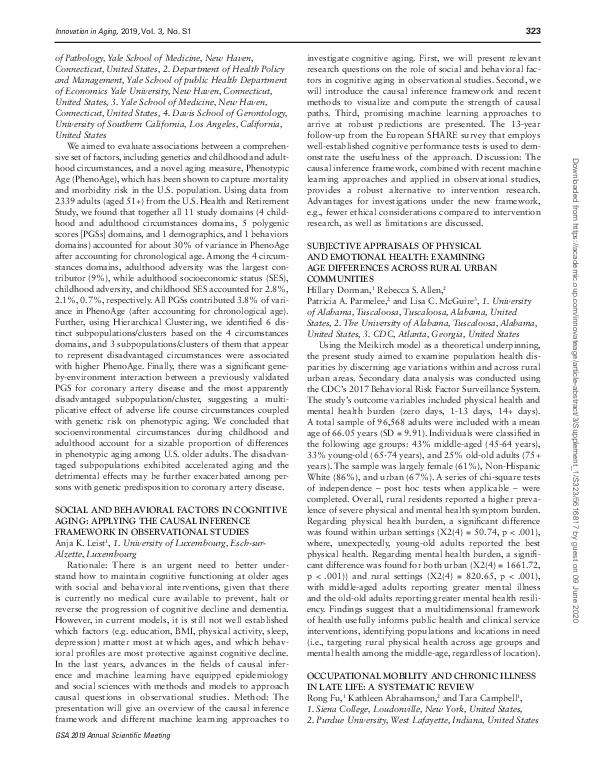Academia.edu no longer supports Internet Explorer.
To browse Academia.edu and the wider internet faster and more securely, please take a few seconds to upgrade your browser.
Subjective Appraisals of Physical and Emotional Health: Examining Age Differences Across Rural Urban Communities
Subjective Appraisals of Physical and Emotional Health: Examining Age Differences Across Rural Urban Communities
2019, Innovation in Aging
Using the Meikirch model as a theoretical underpinning, the present study aimed to examine population health disparities by discerning age variations within and across rural urban areas. Secondary data analysis was conducted using the CDC’s 2017 Behavioral Risk Factor Surveillance System. The study’s outcome variables included physical health and mental health burden (zero days, 1-13 days, 14+ days). A total sample of 96,568 adults were included with a mean age of 66.05 years (SD = 9.91). Individuals were classified in the following age groups: 43% middle-aged (45-64 years), 33% young-old (65-74 years), and 25% old-old adults (75+ years). The sample was largely female (61%), Non-Hispanic White (86%), and urban (67%). A series of chi-square tests of independence – post hoc tests when applicable – were completed. Overall, rural residents reported a higher prevalence of severe physical and mental health symptom burden. Regarding physical health burden, a significant difference was foun...
Related Papers
The Journal of Rural Health
Quality of Life in Rural and Urban Adults 65 Years and Older: Findings From the National Health and Nutrition Examination Survey2012 •
2018 •
Differences in life outlook and self-perceived health often attributed to age differences among the elderly were found to be more accurately explained by education. The young-old (62-74 years) and the old-old (75years and older) were compared among 495elderly in two rural counties in western Arkansas. The old-old were more likelythan the young-old to perceive their health as better than that of others their age. But when six variables including age were entered into a predictive model forself-perceived health, differences were explained by education. That is, those with better educations rated their health more positively. There was no difference between the two age groups in sick days, although the old-old reported more days hospitalized and trips to the doctor. However, no predictive model for health status measured was statistically significant. On measures of life satisfaction, the old-old were slightly more pessimistic than the young-old. But the age difference in life outlook ...
The Journal of Rural Health
Self-rated Health Among Vulnerable Older Adults in Rural Appalachia2005 •
The Journal of Rural Health
The Relationship Between Rural Status, Individual Characteristics, and Self-Rated Health in the Behavioral Risk Factor Surveillance System2012 •
JAMA Network Open
Trends in Mental and Physical Health-Related Quality of Life in Low-Income Older Persons in the United States, 2003 to 20172019 •
The journals of gerontology. Series B, Psychological sciences and social sciences
Using and interpreting mental health measures in the National Social Life, Health, and Aging Project2014 •
National Social Life, Health, and Aging Project (NSHAP) included five unique mental health measures in Waves 1 and 2 that researchers can use to measure the overall emotional health of participants: depressive symptoms, happiness-unhappiness, anxiety symptoms, perceived stress, and felt loneliness. For each, we detail the rationale for its development and explain how to score, analyze, and interpret results. NSHAP developed its measures by modifying traditional short-form scales to improve response efficiency and reduce respondent burden. Scoring protocols and interpretations were developed for each measure. U.S. population estimates for older adults born between 1920 and 1947 were generated using age-eligible samples from Waves 1 and 2. NSHAP's protocols yielded U.S. prevalence rates similar to other nationally representative studies of older adults and comparable between waves. Higher estimates of anxiety symptoms and perceived stress in Wave 2 compared with Wave 1 were explai...
“Materia giudaica” XIV/ 1-2 (2009) sed 2010, pp. 35-62.
Giovanni Spano e gli ebrei di Sardegna2010 •
In this study the author examines the attitude of Giovanni Spano (1803-1878) - a learned ecclesiastical scholar in Sardinia during the 19th century - towards the Jews and Judaism, as it appears from his “History of the Jews in Sardinia” published in Cagliari in 1875. Spano, who studied oriental languages in Rome at the University “La Sapienza” and not in an ecclesiastical or Pontifical institution, was a pioneer in the study of the presence of the Jews in Sardinia. He considered the Jews as Sardinian people for almost 1500 years and appreciated their values and merits in the development of the commercial activities. His attitude towards them is characterized by a total absence of anti-Semitism, which on the contrary was still widespread in the Catholic Church at that time, and by a sympathetic evaluation of their capacities. In the second part the author describes two Hebrew manuscripts which belonged to Giovanni Spano’s collection, now preserved at the university library in Cagliari.
RELATED PAPERS
Law and Policy
Smallpox Vaccination and the Limits of Governing through Contagion in the Straits Settlements, 1868-19262023 •
Microscopy and Microanalysis
How Fast is Your Detector? The Effect of Temporal Response on Image Quality2023 •
Biochemical and Biophysical Research Communications
Inhibition by digitonin of bovine heart muscle DPNH-cytochrome c reductase and its specific reversal by the tocopherols1964 •
Journal of Medical Ultrasonics
Coexistent borderline serous cystadenoma with multifocal hydatidosis in a young female: lessons learnt2016 •
Frontiers in Microbiology
Pervasive effects of a dominant foliar endophytic fungus on host genetic and phenotypic expression in a tropical tree2014 •
Phytopathology
Phytochemical screening of stem bark of valuable medicinal tree of tropical forest-Pterocarpus marsupium (Roxb.)2020 •
The Impact of Globalization on Economic Security and Innovative Public Management Tools for the Development of Strategies for Ensuring the Spheres of National Security
The Impact of Globalization on Economic Security and Innovative Public Management Tools for the Development of Strategies for Ensuring the Spheres of National Security/ Kateryna Blishchuk, Pavlo Slisar, Roman Pasichnyi, Igor Britchenko, Oleksandr Yurkivskyi, Olena Bobrovska//Economic Affairs2024 •

 Rebecca Allen
Rebecca Allen